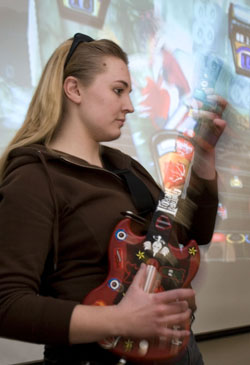The game behind the guitar

Katie Malazdrewicz demonstrated considerable skill during the competition section of the Second Annual Games Studies Symposium co-organized by gameCODE and Ludiciné. The event was held in the Sociology and Anthropology Department in the Hall Building.
Andrew Dobrowolskyj
The 11th floor of the Hall building is rarely rocked by the riffs of Wolfmother and Heart, but Guitar Hero 2 was the focus of the Second Annual Game Studies Symposium.
The symposium was co-organized by Montreal gameCODE, a group of researchers based in the Sociology and Anthropology Department who apply a socio-cultural analysis to video gaming cultures.
Each year the group, which began at Concordia in 2004, takes “a game we’ve never done research on, and turns it into an object of collective inquiry,” said sociology professor and event co-host Bart Simon.
Guitar Hero is a console game. Players hook a guitar shaped interface, with five coloured buttons along its neck, up to a Playstation and TV monitor, instead of a regular controller. Players can work either cooperatively or competitively to play songs by following the colour-coded cues on the screen at the rhythm indicated. The more notes you get right, the more star power and points you rack up. Success also translates into money that, in turn, earns you better equipment, outfits and a larger repertoire of music to choose from.
Members of gameCODE immersed themselves in Guitar Hero in the weeks leading up to the symposium. A panel where professors and students presented papers on their impressions of the game was bookended by a competition.
Sixteen would-be rock stars battled it out, thus the unusual soundtrack for a Friday afternoon. The event drew people from all four Montreal universities, as well as game developers from Ubisoft and other studios around the city.
Simon, who provided the introductory remarks, noted that the musical selections in the game, like Judas Priest, Van Halen and Black Sabbath, were a far cry from the Carole King, Bob Dylan and Phil Ochs that he listened to while growing up.
Co-organizer Bernard Perron, of Ludiciné (Department of Art History and Cinema at Université de Montréal), acknowledged that heavy metal was his music of choice. He pointed out that the game combines two of parents’ worst nightmares, “The kids are downstairs playing video games, and the music is really, really loud.”
Katie Malazdrewicz, one of two women to compete, added privately, “Guitar Hero offers a wholesome kind of badass.”
Simon pointed out that the game is designed to be performative, it is best played in a group with players providing an audience for each others’ exploits.
While proficiency is rewarded, there is entertainment to be found in the “spectacle of failure” as he put it. He drew the parallel with American Idol, which draws big audiences early in the season when spectacularly bad non-singers are foregrounded.
Cindy Poremba expanded on that theme during her presentation. “As an incompetent player, you can have your audience as well.” And later added that the real fun of the game is not its relationship to making music but that “it’s a simulation of the experience of playing guitar.” The fun is in imagining that you are a rock star, not in trying to be one.
During the discussion, other gamers commented on the growing number of interactive, party video games available. This proliferation challenges the myth of the anti-social loner who is hooked into a machine more often than a social group.
Poremba and Malazdrewicz made it to the semi-finals, but in the end, Guillaume Roux-Girard walked away the Guitar Hero.